The Ice Age
The end of the Ice Age was marked by significant climatic and environmental changes. Global warming was one of them, with higher temperatures marking the transition to the Holocene. Another characteristic was the melting of the ice caps, a period in which large glaciers went away, raising sea levels and altering landscapes.
Finally, the vegetation changed, with tundra and steppes being replaced by forests, which had a great impact in the ecosystems.

The impact on the fauna was no less severe. Giant animals went extinct, and mammoths, saber-toothed tigers, and giant sloths disappeared due to climate change and hunting by humans. Species had to adapt, with smaller animals thriving, while cold-climate species migrated or became extinct, and alongside the humans expanded, adapted, and developed new hunting and agricultural techniques.
This period has also been widely portrayed in cinema, with the animated film Ice Age being a highlight.
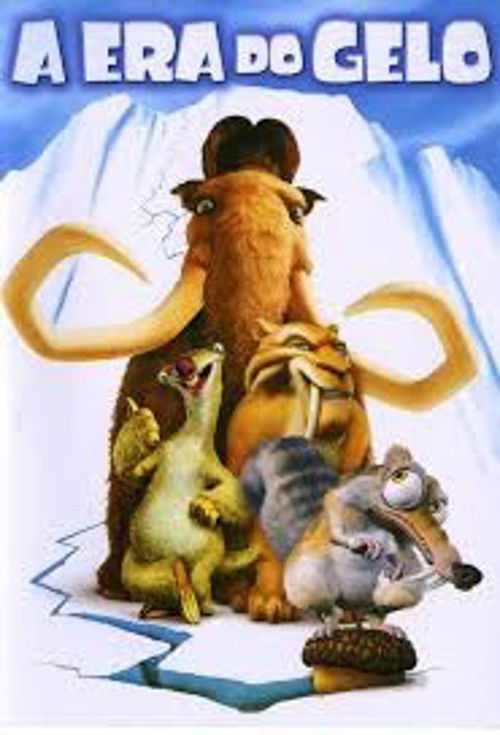
This is the same period where today's game take place: Dominant Species: The Card Game.
Dominant Species: Game Info
Dominant Species: The Card Game, which from now on will be simply referred to as Dominant Species, is a 2-to-6 players game, age 13+, by designer Chad Jensen. He's also responsible for the game's art, alongside Rodger B. MacGowan and Chechu Nieto.
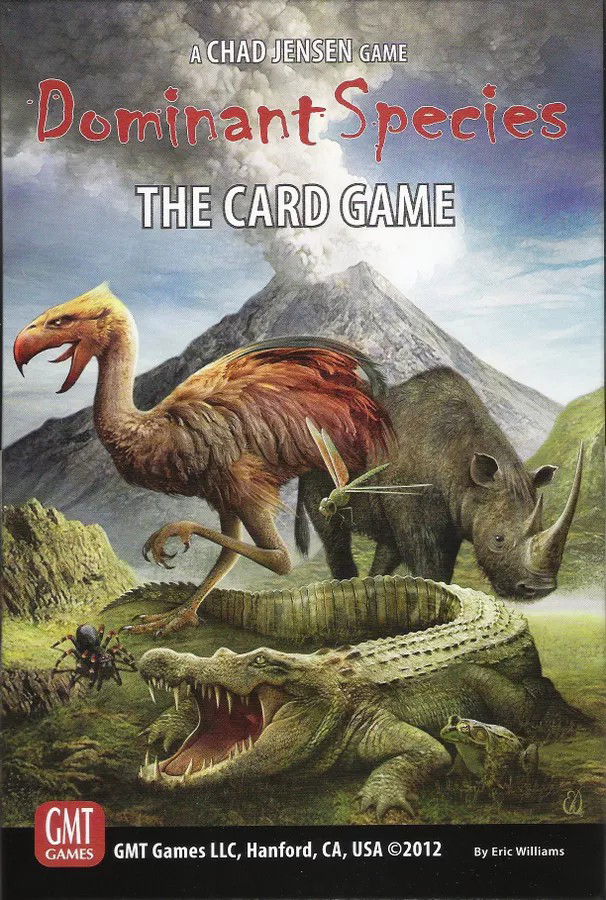
Dominant Species was released in 2012 by GMT Games. The game's main mechanic is hand management.
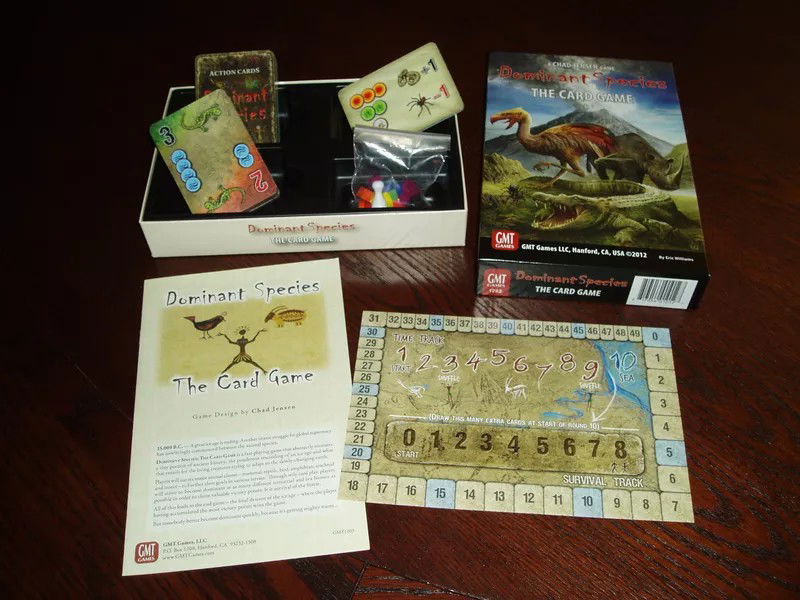
Dominant Species: The Card Game was created after the 2010 Dominant Species board game, by the same designer. It's a somewhat simplified version of the original. In 2013, just like it's predecessor, it was nominated for Best International Game by Boardgames Australia Awards.
Playing the Game
15,000 B.C. — A great ice age is ending. Another titanic struggle for global supremacy has unwittingly commenced between the animal species. The living creatures are trying to adapt to the slowly-changing Earth.
Players will use six major animal classes to further their goals in various terrain. Through wily card play, they will strive to become dominant at as many different terrestrial and sea biomes as possible in order to claim valuable victory points: It is survival of the fittest.
This is the scenario for Dominant Species!
The game has 10 rounds of play, each one on a different biome. It must be noted that there are more than 10 biome cards, which means the game has excellent replayability. The game has a clever scoring system, where victory points are earned according to the current round number: Round 1 is worh one point, and then each round is worth one more than the last one, so the fight for dominance becomes more and more fierce as the game goes on.
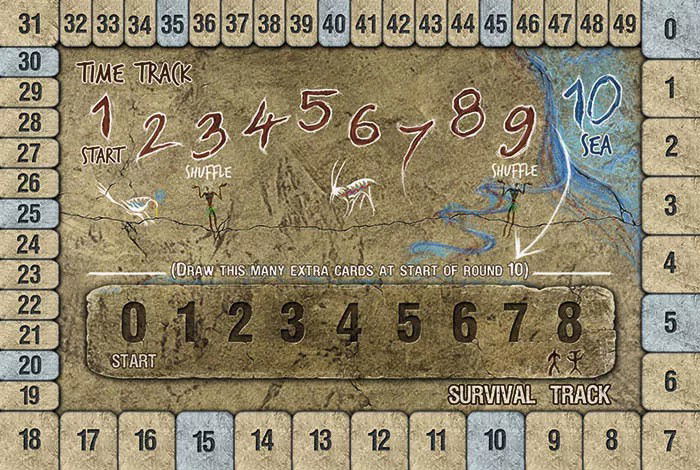
Note: You can only advance on the survival scoring track if you achieve dominance, and this makes a huge difference at key moments in the game and especially in the final score. The animals' adaptation to the current biome during the round is also relevant; there's fight for adaptation throughout the game, and its impact is significant.
There are eight biomes in total:
- tundra;
- mountain;
- desert;
- forest;
- jungle;
- savannah;
- wetlands;
- sea.
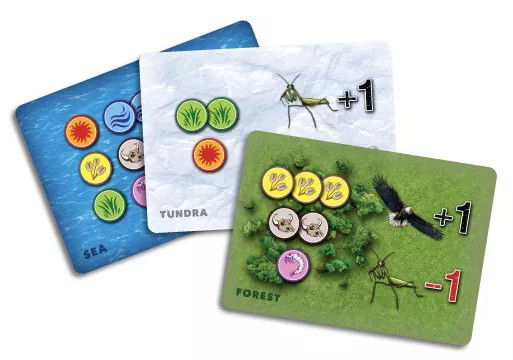
The biome card displays the name of the active biome for the round, as well as the elements that score points in that round. The number in each icon represents how much you score if you have a majority of those elements on your animal cards. It also displays a species that adapts well to the active biome, increasing its dominance by 1 point, and another species that doesn't adapt well to the active biome, deducting 1 point from its dominance. Biome cards truly make a difference in the game.
Regarding the elements, on the animal cards, they represent the resources the various animals need to thrive, and on the biome card, they represent the available supply. There are 6 of them:
- grass;
- grub;
- meat;
- seed;
- sun;
- water.

At the start of each round, a biome card is revealed, placed in the center as active, and also keeping the next biome card in the deck visible. Finally, all players receive 7 cards, including:
- animal cards;
- event cards.
The animal cards feature 6 different species, namely:
- mammals;
- reptiles;
- birds;
- amphibians;
- arachnids;
- insects.

Animal cards display the image of the species, a black value indicating its health and dominance, and some markers for elements of a biome it needs, and sometimes some markers for species that are endangered.
If you turn the card upside down, that is, rotate it 180 degrees, you'll see the endangered version, near extinction, with a lower dominance value in red, and, of course, fewer element markers.
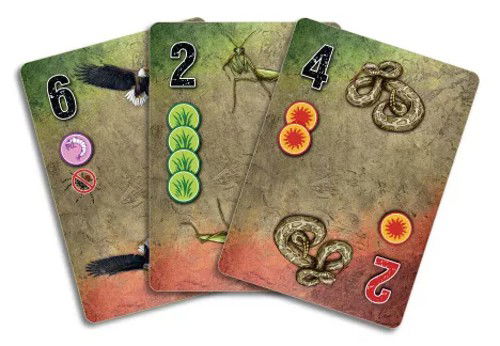
Event cards produce effects that significantly impact the game, namely:
- ongoing events: These remain in play until the end of the current round, activated at the time they are played or later, and have a double-arrow symbol;
- one-time events: These are executed immediately upon playing, after which the card is discarded, and have a left-arrow symbol.
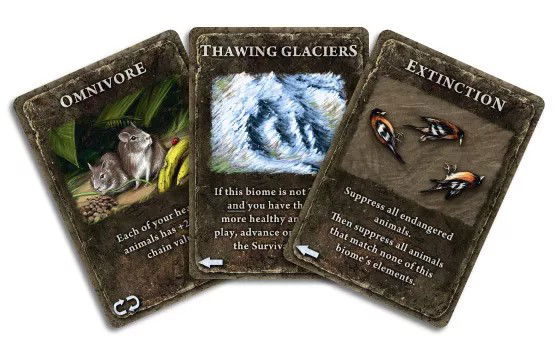
Each turn you choose one of two possible actions:
- play a card from hand;
- pass.
The first option, play a card from hand, can be either an animal card or event card. As the turns go round, you'll have several animals in play, enough to form a food chain, with their added values becoming your dominance.
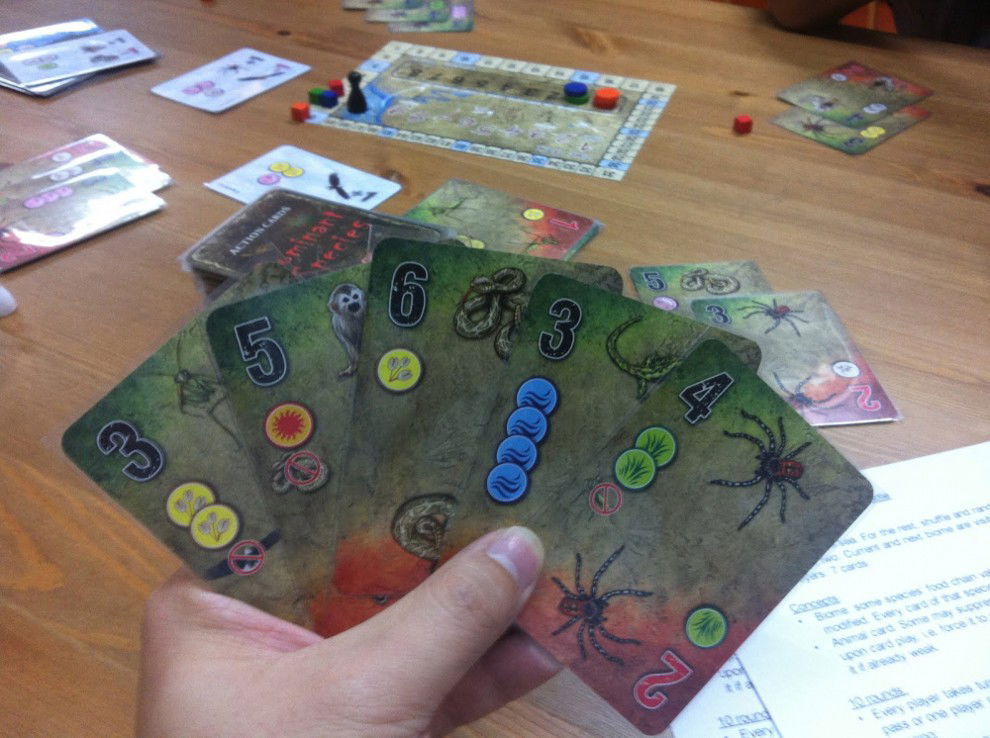
If an animal card indicates that it can suppress another species, choose one card of that species in play from an opponent and turn it 180º - it's now an endangered species. If another card of the same species becomes endangered, extinction follows - remove them from the game.
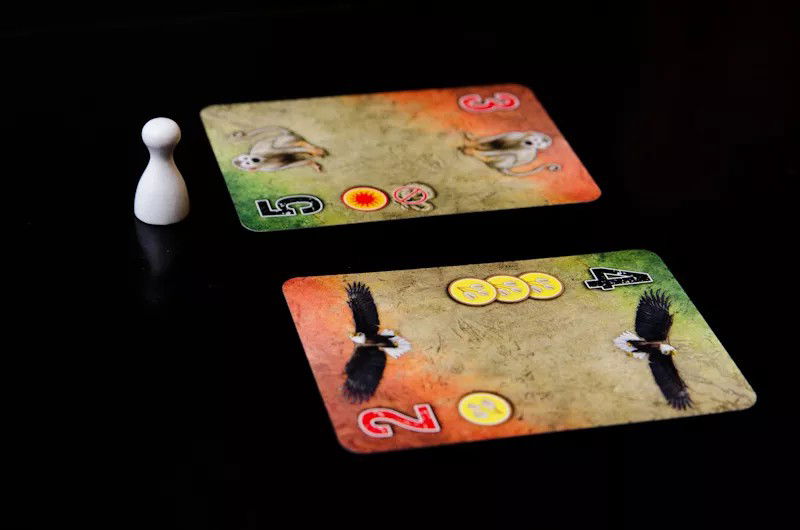
If you choose to play an event card, if it's an ongoing event, it normally will remain active until the end of the round, depending on what else happens. If it's a one-time event, apply its effect and discard it afterwards.
The only other option is to pass, meaning you don't play any cards. However, even if you don't play any more cards this round, your previously played animal cards will still be subject to any threats that appear.
The round continues until:
- everyone passes;
- or a player who passes has no cards in hand.
If either of these happen, the current Round ends, and thus begins the scoring phase.
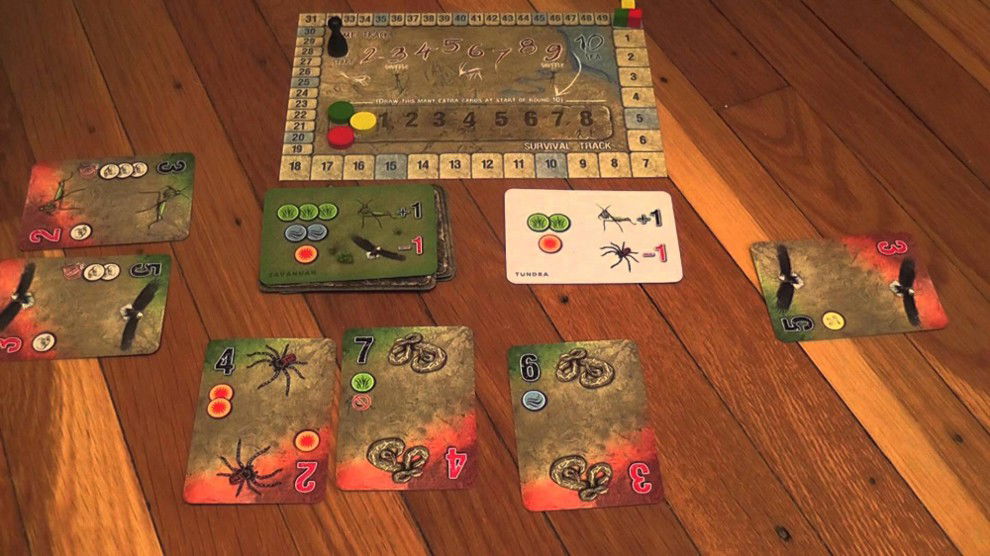
To scoring for the round, check dominance and the biome's elements, like this:
Dominance:
- The player with the highest total dominance value among their animal cards in their food chain is the dominant;
- They earn X victory points, where X equals the current round's value;
- If there's a tie, both players receive points equal to the current round's value;
- Those who scored in dominance advance 1 tile on the survival track (which I'll explain in a bit).
Biome Elements:
- Score for all the elements on the biome card, one at a time;
- The player with the highest total in one element on the biome card earns X victory points, where X equals the number of elements on the biome card;
- If there's a tie, the tied players receive the same point(s).
After this, do a "cleanup" phase before the next round:
- Place the new biome card;
- All animal cards and ongoing events in play go to the discard pile;
- Advance the timeline by 1 space;
- Each player draws 2 cards from the action card deck;
- The player to the left of the previous starting player will be the first in the new round.
This is a round of Dominant Species!
Ending the Game
The game ends after the tenth round is scored, and all players' scores are tallied. Then, award extra victory points as follows:
- The player(s) leading on the survival track earn(s) 5 victory points;
- The player(s) last on the survival track lose(s) 5 victory points.
After this, the player with the highest score wins.
If there is a tie, among the tied players, the player who's ahead on the survival track wins. If the tie persists, among the tied players, the player with the most cards in hand wins. In the unlikely event of a tie still persisting, the victory is shared.
Strategy Tips
Dominant Species is also about knowing the right time to fight for dominance, food, or environmental change. All of this is possible through animal cards and event cards. Competing for available food in the biome is always a good idea, but fighting tooth and nail for dominance at the beginning of the game isn't smart.
The points awarded for dominance at the first rounds of play are too little to justify spending lots of cards on them. After all, the points are equal to the value of the current round, meaning the first round is only worth 1 point. Therefore, it's best to save your resources for later rounds.
Ongoing event cards are valid until the end of the round in which they were played. Knowing this, the most strategic approach is to play them early in the round, especially if the card's effect is beneficial to you and detrimental to your opponents; this way, its effect will have a greater impact.
Another important detail is that at the end of rounds 3 and 9, the discard deck is reshuffled into the main deck, so there's a chance some events will happen again. This completely changes the game.
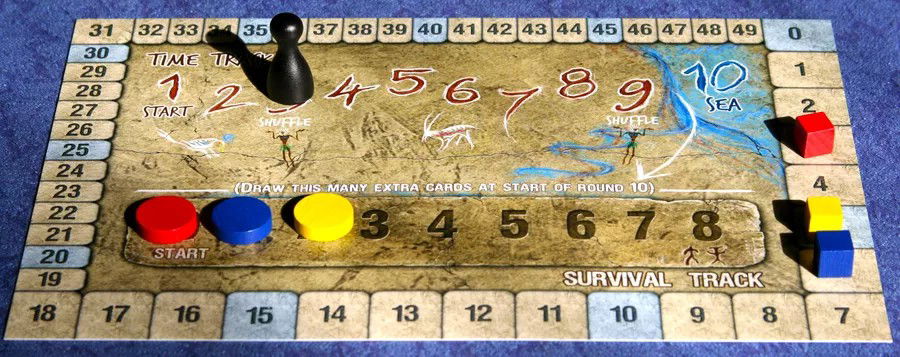
Also very important: at the beginning of the tenth round, after players have drawn their two cards, each player draws X extra cards, where X equals the player's current position on the survival track. This is where the survival track is really impactful, since the tenth round is also the one that awards most points for dominance. So, having more cards is essential.
And don't forget that in the end, being first on the survival track earns you 5 extra points, which can be enough to overtake whoever was in first-place before. In other words, you have adapted better to the different biomes and achieved greater dominance. Another possible scenario is that a player is first in the score and last on the survival track, thus losing 5 points and potentially losing the game. Keep an eye on the survival track.
Based on these tips, develop your best strategy, seek dominance at the right time, and win in Dominant Species.
Unboxing and Rules Videos
Unboxing:
Rules:
Pedagogical Tips
If you're looking for a game based on historical facts, easy to teach and play, provides excellent and important stimuli, and is also entertaining, Dominant Species is the game for you.
I recommend you start by talking about the end of the Ice Age and its impacts; this will make for a good and very interesting history lesson. You can also bring in the Ice Age animation to help the child get immersed; it will be a lot of fun.
Afterwards, kids will notice the animals on the cards, the biomes, the food, and even which animals adapt best to a given biome and which don't thrive. They will learn through playing.
The event cards feature relevant facts about the end of the Ice Age, so they can understand how everything happened and its impact - both in the game, and in reality. This is very interesting and fun.
During the game, they'll learn to choose the best time to play a certain card, which card to play, and whether or not it's time to seek dominance or simply fight for food in the biomes. This is all about management and decision-making.
They'll practice logical and mathematical reasoning while adding up their dominance points in their food chain, or deducting points when an animal in their food chain is suppressed and endangered. These are simple calculations that will encourage children to practice math without realizing it.
Pedagogically, Dominant Species encourages strategy, management, decision-making, logical and mathematical reasoning, provides a history lesson, and, to top it all off, is fun!
I recommend Dominant Species for your collection!!!












— Comments 0
, Reactions 1
Be the first to comment